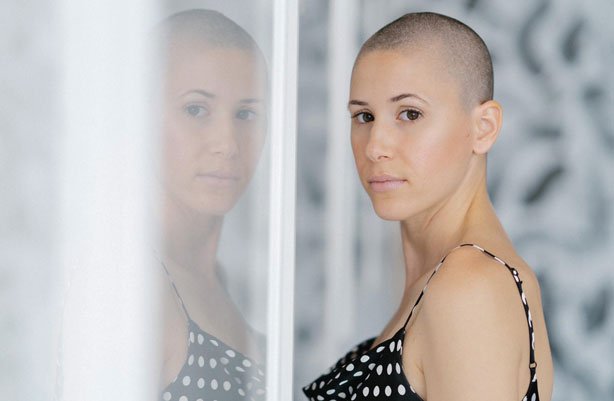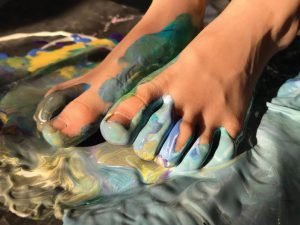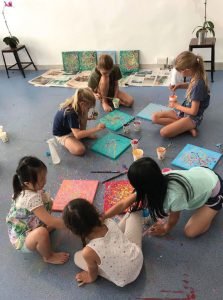
Art for life – With Italian Artist Roberta Boffo
- bey0ndM@gz!ne
- August 6, 2020
- Cover Story, Default, People-Perspective
- 0 Comments
 Roberta Boffo is many things, but I would best describe her as unflinchingly passionate when it comes to art. Not only does she run classes for kids and adults, but she also supports other local artists at her award-winning studio in Sai Kung.
Roberta Boffo is many things, but I would best describe her as unflinchingly passionate when it comes to art. Not only does she run classes for kids and adults, but she also supports other local artists at her award-winning studio in Sai Kung.
With an extensive history in art education, Roberta applies her skills and knowledge to spread the love of art wherever she goes. Using ink with calligraphy brushes of different sizes and fine liners, her work is anything but simple. Her paintings are incredibly detailed using a combination of lines, shapes, and forms with dot work, some taking up to 160 hours to complete. In her own words, she believes her “purpose as an artist is to make art that does not follow the rules, that is radical, that calls the viewer to walk into it and look for more. It is a dialogue in a language you’ve never spoken before. It is my way to call you to embrace that dialogue and connect with me. I believe art is connectivity, not only between you and me but also within yourself. “
Roberta, the little I’ve known of you in the last few years, I have seen how vocal you are about art being an essential part of everyone’s life.
What according to you, is the importance of art in today’s society?
I believe the importance of art in today’s society is bound to its spirituality and our emotionality. Art is the visual language for our emotions, experiences and life stories. Individuals who rediscover the power of art can improve society, add harmony and bring people together. Art can soothe, lift spirits and mend broken ones. Art can help express every feeling from joy to anger that perhaps words cannot. Artist O’Keeffe says it well: “I found I could say things with colour and shapes that I couldn’t say any other way – things I had no words for.” In this way, art is an invitation to connect, between the viewer and the artist, and art and society.
Art teaches you and the people around you as it empowers everyone to act upon that connection. It invites you to be emotionally involved and to show your vulnerability. For me, art is a pathway to empathy and caring for one another in more profound ways.
Everyone can see how much you love working with children. In fact, we met because you helped my daughter out with her grade 6 PYP (IB Primary year program) exhibition on Art Therapy. What role do you think art has in helping and influencing growth in children?
Art is a very humbling process. It promotes empathy and the ability to connect with others because we learn how to connect with ourselves. We learn to listen and to give importance to our emotions, and therefore it enables us to listen and give importance to others and their stories. These are all fundamental life skills.
Artists are creators, which means that they learn much more than just a set of skills, or techniques. Being an artist means taking charge of your creative process. It means choosing for yourself, and deepen your learning independently. Artists create something that starts in emotion and then decipher and decode that emotion. Reflecting on our art and understanding ourselves through our work is very important. It enriches our growth and development – whether we are young or old; it gives us clarity.
Does art play a different role in life depending on the age of the children? How does the role differ in the life of a toddler vs a teenager?
When we are young, art, just like food, is fun and playful. How many times have we seen babies play with their food? For babies and toddlers, art is exploration, a sensory experience. Children like to play with something as simple as the coloured water from washing the paint off the brushes. Children also love to paint with their hands, stomping on paint and then walking off, leaving footsteps all over the place. These are some of the first steps in their path to self-discovery. At this early stage, kids will just use different mediums and try various tools. As they grow, they will become more selective in their tools and mediums choices. I feel art is a way to discover and learn about yourself and also connect with others. As kids keep growing, their approach to art also evolves. It becomes more than playtime into a time of reflection, of pause, relaxation, and meditation. Through art, teenagers also get to process all that they are exposed to in life. They get to process their experiences and emotions creatively and healthily.
 We all understand how crucial it is for artists, in general, to share insights on their work and connect with other artists around them. It is such a meaningful and healing process as we show our vulnerability by sharing our work. So yes, art plays different roles, but its significance, its importance and its undeniable necessity to be part of everyone’s life does not change.
We all understand how crucial it is for artists, in general, to share insights on their work and connect with other artists around them. It is such a meaningful and healing process as we show our vulnerability by sharing our work. So yes, art plays different roles, but its significance, its importance and its undeniable necessity to be part of everyone’s life does not change.
Have you noticed any significant changes in children’s behaviour or personality after they start including art in their daily lives?
I work with many young students weekly, so I’ll share a few examples of some of the changes and accomplishments that I’ve seen in my time as an art “whisperer”, (I prefer that to “an art teacher” for some reason).
First of all, let me say that all great things take time, patience, practice, dedication, perseverance, discipline, hard work, and an eye for detail which one cannot implement unless you have the right attitude. All my young apprentices have been taught this in my classes. Having said so, I have also had quite a few kids who previously attended classes in more traditional and structured art studios. I will always remember at the very beginning, it was challenging for them and a little sad for me to see them struggle with doing art with a certain amount of freedom and independence.
Some of these young artists are now well underway on the path of self-discovery and are very insightful regarding their work and process. I had a young student telling me that the tinier the dots are, the more she can concentrate. And this particular student has been working on the same artwork for over a year now.
 Every week she comes and pours herself into her work, I can see how calming and relaxing it is for her. I have a teenage student who is so in love with watercolours, and her confidence has gone through the roof! I asked her recently why she paints leaves, plants and flowers most of the time and she replied by saying she loves the movement of the brush when she paints these subjects, “I find it so relaxing, it helps me to get rid of my tension” (as Picasso calls it “the dust of everyday life”). So yes, the change is incredible when you truly look at how some of these young people started. In observing so many of them, I can say that I have seen a lot of changes in their personalities. From being timid and shy they have become open and confident, and from hesitating a lot they now show a lot of initiative.
Every week she comes and pours herself into her work, I can see how calming and relaxing it is for her. I have a teenage student who is so in love with watercolours, and her confidence has gone through the roof! I asked her recently why she paints leaves, plants and flowers most of the time and she replied by saying she loves the movement of the brush when she paints these subjects, “I find it so relaxing, it helps me to get rid of my tension” (as Picasso calls it “the dust of everyday life”). So yes, the change is incredible when you truly look at how some of these young people started. In observing so many of them, I can say that I have seen a lot of changes in their personalities. From being timid and shy they have become open and confident, and from hesitating a lot they now show a lot of initiative.
Some who were not very talkative now share easily, and from showing little interest initially, they are now excited to create. So much so that after about three months of suspended workshops due to the pandemic, kids have been very eager to come back as they really missed the classes.
Your work has a unique style, and though you have often expressed your love for simplicity, your work is far from simple. Your art might be in the form of lines and dots, but there is a lot of technique that goes into it. Could you talk about your style a little?
There are a few quotes that I love that truly speak my mind about art and specifically my practice. One of my favourites is “Simplicity is the ultimate sophistication” by none other than Da Vinci. When I was in school studying art and looking at different masters, I fell in love with Kandinsky. I just don’t know why, but I would feel so much by simply glancing at his paintings. The colours and the myriad of lines, forms, shapes, dots, spots, it all clicked with me in a way that I cannot describe. It took me almost a decade to develop my current styles. I love using fine liners, pigment pens and Chinese calligraphy brushes with ink. My works are abstract and extremely detailed.
 To talk about my style, I need to talk about the crucial influence that my art teacher had on me when she introduced me to pattern and linework, a long time back. I need to mention how much I am into the colour black, and it is the colour that dominates most of my artwork. I love darkness, and I love the night. I am calmest and most grateful when surrounded by nature. I cherish my deep and spiritual connection with trees; their magnificence is so humbling.
To talk about my style, I need to talk about the crucial influence that my art teacher had on me when she introduced me to pattern and linework, a long time back. I need to mention how much I am into the colour black, and it is the colour that dominates most of my artwork. I love darkness, and I love the night. I am calmest and most grateful when surrounded by nature. I cherish my deep and spiritual connection with trees; their magnificence is so humbling.
Which is why I paint tree rings. I am an intuitive artist who rejoices in the flawless flowing of ink on paper. I obliterate my existence in myriads of tiny details and their infinite repetitions. I live in the peaceful, harmonious and gentle works that I create, with incredible patience and meticulous precision. My art is a reflection of me.
And so it is in the way I teach art as well. When I decided to move from Italy to Beijing, I wanted to be fluent like the locals and learn all the cultural flavours of the language. My love for Chinese culture is another huge element that influences my work which is why I use calligraphy
and ink.
How would you describe the art scene in Hong Kong?
I find the art scene in Hong Kong is very much alive, and the city is bubbling with artists. I will admit, though, I think it could use a bit more diversity. I find that there is an incredible amount of art that is locally inspired by the city and Hong Kong’s landscapes and all the beautiful features that make it such a peculiar and colourful city.
You displayed your work at the Asia Contemporary Art show which took place last October. How was that experience? What advice do you have for budding artists in the city who want to take their work to the next level?
Yes, I did. You are touching a sensitive note here. Last October we saw possibly the worst in terms of the protests. You know I have always been very rebellious and a risk-taker, and when the opportunity came up I said, “hell why not”. It was a bit of an investment with a lot of preparation required. Still, I was super excited, so much so that I did not quite evaluate what the actual conditions of our city were at the time. I think that it was a bit of an impulsive decision on my part, honestly.
The number of people that made it through Admiralty to Conrad Hotel – where the ACAS takes place, was minimal, but I was able to meet new people still and connect with other artists and galleries, many who came from overseas. The show brought along another opportunity, and I ended up having my works displayed at Tai Kwun for about five months, which was really great! This year, I was invited to showcase at a few international contemporary art fairs, including the Affordable Art Fair in Melbourne, Marbella Art 2020 in Spain and Art Canton. Sometimes, we have to make decisions that come with a heavy heart, but you have to trust time and believe in yourself and just keep going, keep moving – even if you slow down, it’s ok, just keep moving forward.
Roberta’s work can be found at her gallery in Sai Kung. You can also view her work on her website and social media pages.
https://robertaboffo.com/
https://www.facebook.com/robertaboffoart/
https://www.instagram.com/robertaboffoart/




